When you live in this part of the Deep South, the holidays are not over when the Christmas tree comes down.
Jan. 6 is the feast of the Epiphany, also designated as Twelfth Night, when the countdown to Mardi Gras begins. Whether you celebrate in New Orleans, Mobile, or Mamou, folks will dress extravagantly for their krewe’s ball and put final touches on their Carnival costumes.
Even this far out from Mardi Gras (Fat Tuesday), diehard partygoers are beading up in the ditches or streets, at least three daiquiris deep, surviving on links of boudin, spicy jambalaya and generous slivers of King Cake.
However, for folks in rural areas of South Louisiana, this is gonna be a whole ‘nother type of party. Sure, you’ll see green, gold and purple everywhere, but they’re not the only traditional colors. Costumed participants and spectators of the Courir de Mardi Gras embrace whatever colors they can find in Tante Sue’s box of fabric scraps.
Carnival traditions vary from urban to rural areas in the state; the only “rule” is to experience this merry season of misrule. However, deep in Cajun and Creole country, the “Mardi Gras run” enjoys its own special history.
Talking to participants, it’s clear that many hope to see these runs return to their more traditional roots. They’re opting for courir revivals that remind them of the Mardi Gras of their childhood. Riders, runners and residents relish the imitation of early begging practices that have been celebrated tout le monde for centuries, depending on the season. On the Christian calendar, Carnival is the ultimate party before the Lenten season begins. And because so many people in this region can trace their ancestry back to France, as well as the Catholic church, Fat Tuesday is celebrated as the raucous finale before sinners stumble into the confessional.
As the final hours fade into Ash Wednesday, drinking, dancing and feasting are not only de rigeuer, they are practically mandated. You can find people wearing masks and costumes supposedly to “protect one’s identity,” which is a good thing since all Mardi Gras activities are designed to flip social conventions on their head.
Let the bigger cities enjoy their celebrations with street parades and Carnival balls – let the young and the young-at-heart vie for cheap beads, trinkets and other assorted throws. In more rural areas, Mardi Gras is all about chickens, dancing and gumbo – welcome to the courirs!
Many tales have developed to cite the origins of the courir in the New World. Most attribute its creation to medieval Europe where mummers and wassailers would roam from village to village and castle to castle, begging for sustenance from wealthy landowners.
The poor would often dance and sing, hoping that their entertainment would yield plentiful gifts of food and drink to help them survive the long winter months of scarcity.
In a tradition dating back to the 19 th century in some Louisiana communities, Mardi Gras revelers still wait excitedly for the morning ride through the countryside that mimics these customs. Costumed riders on horseback, and their running companions on foot, go begging for a cinq-sou (nickel), or the ingredients for a communal chicken gumbo. And who really needs an excuse to chase the main feathered component around the countryside?
Despite the higher levels of inebriation in modern courirs, many exhausted chickens still find their way into the gumbo pot. The first French immigrants in Louisiana packed up not only their families and belongings to take to their new homes, but also many revered rituals and tales.
According to online sources, “other of the traditions associated with the courir are derived from the folk traditions of pre-Christian Celtic Europe and are associated with fertility and renewal. Examples include the use of the burlap whip and the tune on which the Chanson de Mardi Gras are based, both of which are traced back to Brittany, a Celtic enclave on the Northwestern French coast near where the original settlers of Acadia came from.”
Susana Ortego Guillory of Elton, La., has been making traditional courir costumes for over twenty years. It’s a seamstress craft passed to her by her father’s mother, Winnie Ortego. “My mother didn’t sew. Some of Winnie’s grandchildren like me, learned the craft. Mardi Gras costumes are the only things I sew now. After Mardi Gras is over, I’m tired and stressed, so I spend a few weeksrelaxing before I start working on next year’s costumes.”
Guillory’s Facebook page proudly boasts that colorful pieces of thread can be found “decorating” many spaces in her home this time of year. What you won’t find though, are pre-made garments or scrubs being used in her customized designs. “I’ve been using the same basic pajama pattern for decades, from newborn to adult 3XL.
In the old days, folks used clothing that had been patched until it just wasn’t fit to wear anymore. I’ve also had to learn that different communities have very specific guidelines on how they want their capuchons or masks designed, so I carefully listen and follow their rules. Some want fringe around the bottom of the hat; others do not. And still others don’t want fake noses on their masks.”
Guillory has provided costumes for courirs all over South Louisiana: Ville Platte, Eunice, Elton, Iowa, Church Point, Iota, Basile, Reeves, Oberlin and many other smaller villages, like Perchville (Pas-ta-sa) and Tepetate. She cites a growing trend toward individual family and independent courirs. Organizers tell her that the runs have simply grown too big, so many are choosing smaller courirs, based on the more traditional runs folks remember, dating back to the pre-World War II era.
The capuchon to which she refers, is just one of three types of traditional headdresses found in various Mardi Gras runs. These pointy hats were originally designed to mock the nobility. There are also miter hats to poke fun at the clergy, and mortarboards to ridicule the well-educated. Additionally, gloves and masks are worn to protect the identities of riders and runners.
Men may dress like women, women like men, and the wealthy like the poor — role reversals are all an entertaining part of this day that everywhere else is just a Tuesday.
Following World War II, young men returned to their rural Louisiana communities, increasingly aware that their language and customs owed much to the European heritage of their ancestors. Courir de Mardi Gras was indeed a unique custom – it begged to be resurrected. The Cajun Renaissance, as it is often touted, came about when the music, food, and dances of Cajun country began to be promoted and embraced worldwide.
“Now you must understand that the drinking you see today was not done back in the early days,” Guillory stresses. “Courirs were organized primarily by poor people in the rural areas who couldn’t afford to drink all day. Back then, women were never allowed to run or even follow the riders.
Their place was at the gumbo pot. The wealthier men would return from the run to change into their fancy suits for the dance that always followed. It’s funny, most Cajun men today consider themselves better cooks than the women. Now you’ll find more of them stirring the big black pots.”
Guillory says her grandfather, Eloi Ortego, served as a capitaine, the leader’s role reserved for the first rider that approaches the houses along the route. Singing to ask permission to enter onto their property, and in the spirit of fun, individual Mardi Gras riders will pretend to sneak onto the property. Les capitaines, who might brandish the burlap whip mentioned previously, pretend to hold them in check. But these traditions vary depending on
the location of the courir.
“The whip is not part of the tradition in the Eunice courir,” says Greg Savant, who served as president of that run for 17 years before assuming the role as le capitaine from 1990-97.
“When I first started, we had riders on horseback, but also many people walking the entire 14.5 miles of the designated On the Christian calendar, Carnival is the ultimate party before the Lenten season begins. And because so many people in this region can trace their ancestry back to France, as well as the Catholic church, Fat Tuesday is celebrated as the raucous finale before sinners stumble into the confessional.
As the final hours fade into Ash Wednesday, drinking, dancing and feasting are not only de rigeuer, they are practically mandated. You can find people wearing masks and costumes supposedly to “protect one’s identity,” which is a good thing since all Mardi Gras activities are designed to flip social conventions on their head.
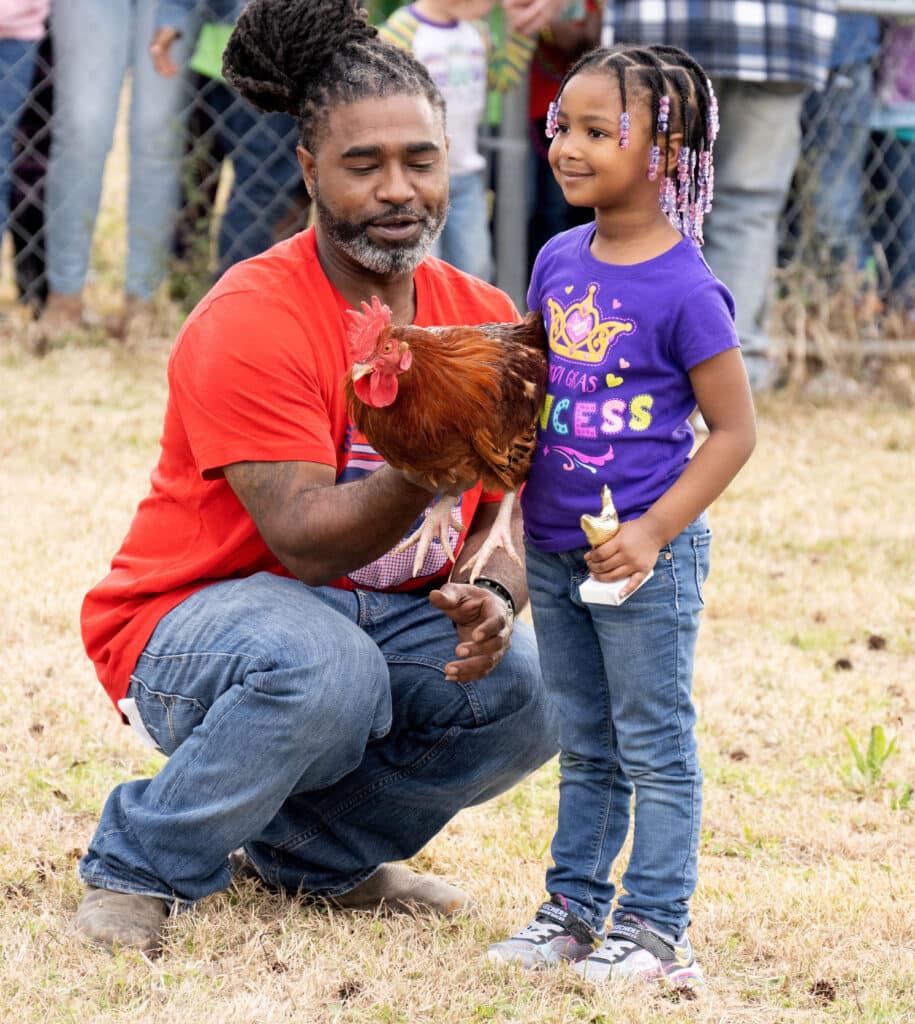
Lebeau Mardi Gras Chicken Run, Immaculate Conception Catholic Church, Feb. 20, 2022: Posing for a photo holding a trophy as the winner of her division of the chicken chase.. Lebeau Mardi Gras organizer Geneva Lemon handed out the trophies and took a photo of each child who won. Photo By David Simpson
Let the bigger cities enjoy their celebrations with street parades and Carnival balls – let the young and the young-at-heart vie for cheap beads, trinkets and other assorted throws. In more rural areas, Mardi Gras is all about chickens, dancing and gumbo – welcome to the courirs!
Many tales have developed to cite the origins of the courir in the New World. Most attribute its creation to medieval Europe where mummers and wassailers would roam from village to village and castle to castle, begging for sustenance from wealthy landowners.
The poor would often dance and sing, hoping that their entertainment would yield plentiful gifts of food and drink to help them survive the long winter months of scarcity.
In a tradition dating back to the 19 th century in some Louisiana communities, Mardi Gras revelers still wait ex when there’s that much drinking involved in that large a crowd. One year, I added a 20-foot cattle trailer to the run. If anyone wanted to fight, they were threatened with being thrown in. There they could fight until the last man standing could ask to get out. No one fought –- just the threat of being removed from the run was enough.”
“With most traditional runs, when you registered in the morning, you had to arrive fully dressed, masked and wearing the capuchon. That rule has become lax in the past few decades. Because these runs have gotten so large, groups have splintered off to start independent runs, limiting the size to maybe the first 150, and only for those who show up in full costume. And let me tell you, these are quickly emerging as the more traditional runs.
I can still recall my maternal grandfather, Elba Fontenot, dressed in full costume, sitting on his porch in Ville Platte, sipping Old Crow as he waited for the run. Those were the courirs many in my generation grew up with. For my older brother Mitch and I, that was what we wanted to do when we grew up.”
Derrick Waguespack agrees. In the South Cameron communities of Creole and Grand Chenier, he joined with other Iraqi and Afghanistan veterans and residents who wanted to resurrect their traditional courir, which can be documented to at least the 1930s.
“These courirs probably date back further, but that’s all we’ve found so far. On our Facebook page, you’ll see newspaper clippings from the 1960s to 2002. Into the 80s, these courirs were a big deal, with gumbos and dancing after the run. After that, it appears that the interest started drying up.
For one thing, hurricanes like Audrey, Rita and Ike have battered this area badly. They’ve taken their toll on the infrastructure. Mardi Gras is hardly a priority when you’re having to rebuild your home and town. After Hurricane Rita hit in September 2005, there were no courirs until our first one in 2014. We ran for six years, until Hurricane Laura brought further devastation to the Cameron Parish coastal communities.”

2023 Eunice Mardi Gras Courir near the start of the run, Feb. 21: the first chicken catcher of the run. Photo By David Simpson
An original core group, including Andy Oliver, Chris Dimas (Marines), Dane Dupont, Cody Styron (Army), Brendan Iler (Marines), Logan Manuel, the Comeaux family and Marine veteran Waguespack started planning in 2013 for their first South Cameron run. Although no run is planned there in 2024, Waguespack attends other area organizational meetings that are reviving more traditional runs. He credits Chance Henry with the revival of the Mermentau Cove courir, Gustave Gravot with one in Lejeune Cove, and J.C. Leger with starting a more traditional offshoot of the Church Point run. Leger’s group calls themselves Les Malfacteurs.
“They’re not really bad boys,” laughs Waguespack, “just very mischievous Mardi Gras.” Some of the organizers were displaced by the hurricanes, forced to move to other parts of Louisiana. But they share a camaraderie and wish to re-establish old customs that will hopefully never blow away.
In South Cameron, the Mardi Gras use cattle trailers to ride throughout the countryside, notes Waguespack. Both men and women can ride together. They make stops at businesses and residences, still chase chickens, and come together afterward for the communal dancing and gumbo. There’s even a chicken chasing event for the kids.
Traditional costumes as well as modern variations are permitted and here, the burlap whip does make an appearance. The new South Cameron courir has been held two weekends before Mardi Gras day, but that is always subject to change.
“So many rural communities had courirs in the past,” notes Waguespack. “It’s hard to keep up with them. My friend, Kalem Dartez says his family once ran the one that took place in Holmwood. There, the tradition included a competition for who had the fanciest streamers pouring from the point of their capuchons.
Some places wear screen masks with painted features; others may have sewn-on cloth features. Long fabric masks are used as well. And there then are the ones that add the long noses, which may look phallic, but it’s all in good fun.”
More than anything, Waguespack says his group formed in the hopes that their beloved communities in Lower Cameron will thrive again soon, enabling the residents to continue to pass on their culture, heritage, and way of life to future generations.



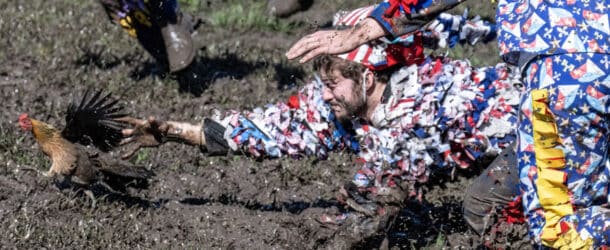
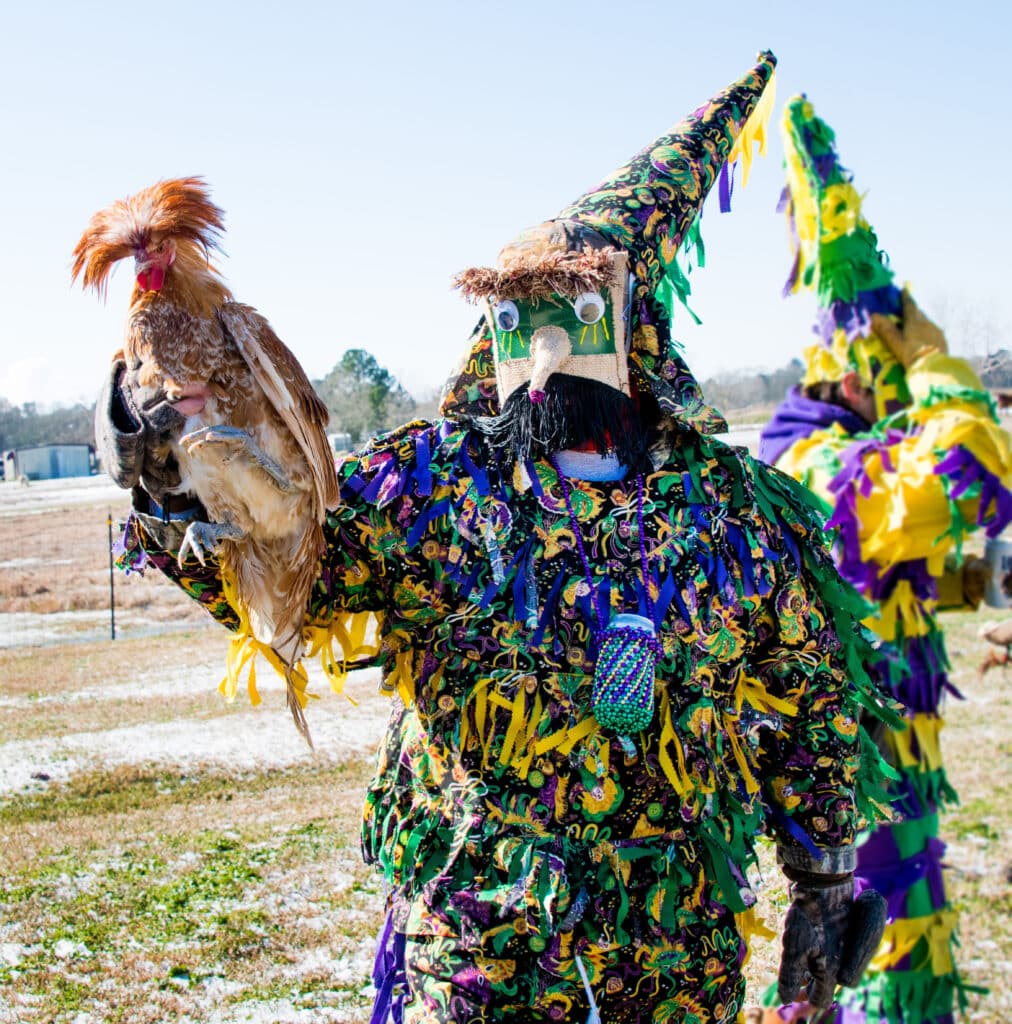
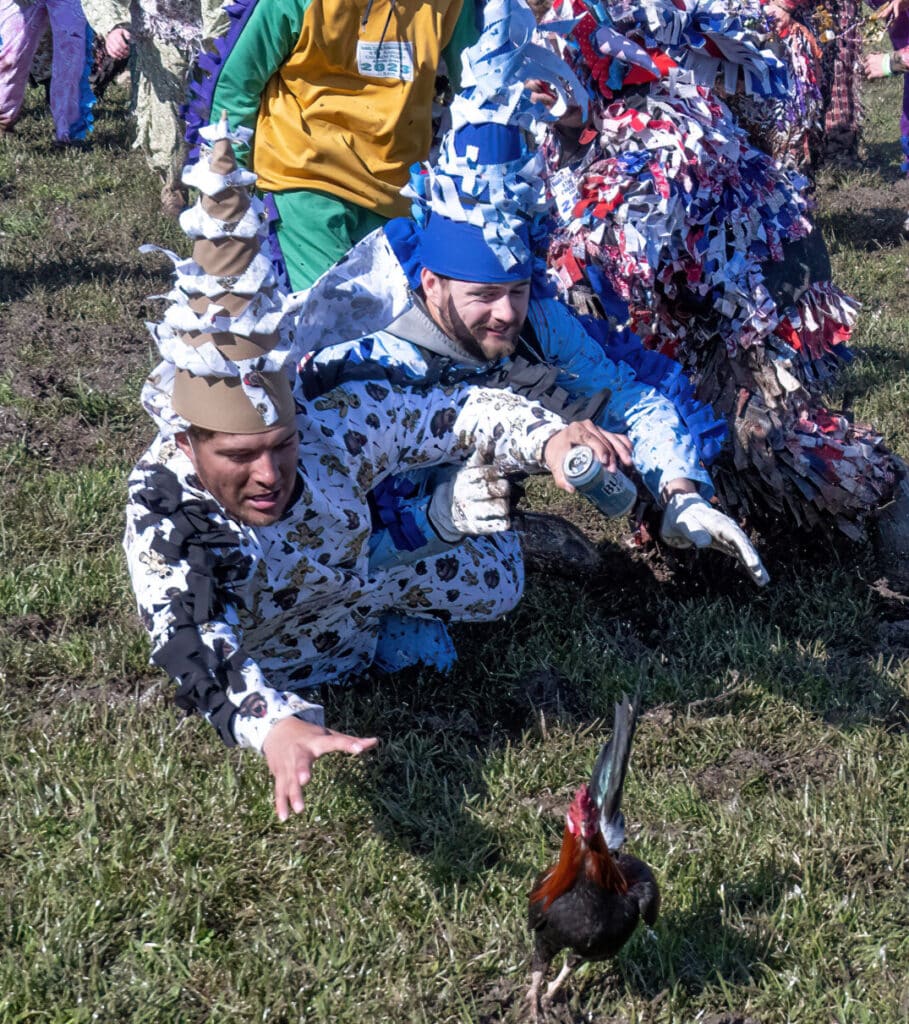
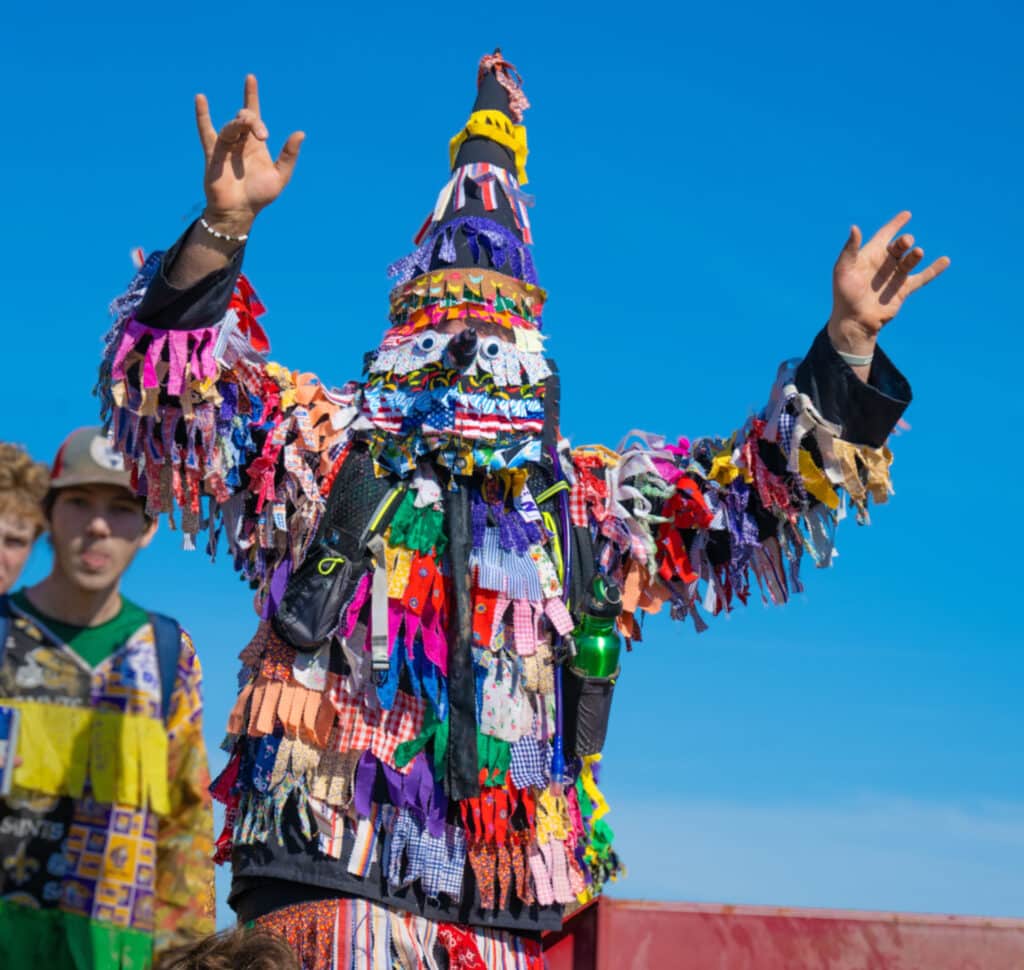












Comments are closed.